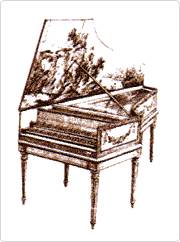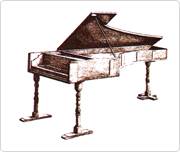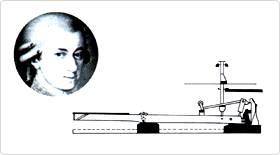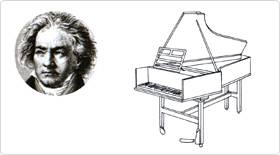- Joined
- Aug 12, 2019
- Posts
- 11,452
- Solutions
- 1
- Reaction
- 27,080
- Points
- 7,071
The Piano's Ancestor was a Monochord Instrument
Instruments can be divided into three categories based on how they produce sounds. Those categories are string instruments, wind instruments, and percussion instruments. The piano's ancestry can be traced back through various instruments such as the clavichord, harpsichord, and dulcimer. But if it were traced back even further, one would find that the piano is a descendant of the monochord. In other words, based on its ancestry the piano can be classified as a string instrument.Origins of the piano

The Piano Has the Same Mechanism as the Dulcimer
Although the piano can be classified as a string instrument due to the fact that the sounds come from the vibration of strings, it can also be classified as a percussion instrument because a hammer strikes those strings. In this way it is similar to a dulcimer.The dulcimer is an instrument that originated in the Middle East and spread to Europe in the 11th century. It features a simple resonating box with strings stretched on top of it. Much like a piano, a small hammer is used to hit the strings, which is why the dulcimer is considered to be a direct ancestor of the piano.

The dulcimer
The Clavichord, a Big Step Towards the Piano
The piano is also considered to be a part of the keyboard family. The history of instruments with keyboards dates far back and originates from the organ, which sends bursts of air through ***** to make sound. Craftsmen improved upon the organ to develop an instrument that was a step closer to the piano, the clavichord.The clavichord first appeared in the 14th century and became popular during the Renaissance Era. Pressing a key would send a brass rod, called a tangent, to strike the string and cause vibrations that emit sound over a range of four to five octaves.

The clavichord
The Piano Looks Like a Harpsichord
Created in Italy in around 1500, the harpsichord later spread to France, Germany, Flanders, and Great Britain. When a key is pressed, a plectrum attached to a long strip of wood called a jack plucks the string to make music.This system of strings and soundboard, and the overall structure of the instrument resemble those that can be found in a piano.

The harpsichord
Cristofori, Creator of the First Piano
The piano was invented by Bartolomeo Cristofori (1655-1731) of Italy.Cristofori was unsatisfied by the lack of control that musicians had over the volume level of the harpsichord. He is credited for switching out the plucking mechanism with a hammer to create the modern piano in around the year 1700.
The instrument was actually first named "clavicembalo col piano e forte" (literally, a harpsichord that can play soft and loud noises). This was shortened to the now common name, "piano."

The mechanism invented by Cristofori

The Cristofori fortepiano
You do not have permission to view the full content of this post. Log in or register now.
The origins of the Piano
Great Composers Who Followed the Advances of the Piano
The Bach-Approved Silbermann Piano
Gottfried Silbermann, a specialist in constructing organs, took over the work that Cristofori began. He studied Cristofori's designs and improved upon them.Not long after in 1747, Johann Sebastian Bach performed one of his historical pieces in front of Frederick the Great on the piano that Silbermann dedicated to the king.

The Silbermann piano
The Piano that Mozart Fell in Love With
A man that contributed greatly to German piano manufacturing was Johann Andreas Stein (1728-1792).Stein improved upon the Silbermann piano mechanism and developed what would later be called the Viennese action, a new system that was used for many years and gained much popularity. This new piano featured a bright tone quality and a keyboard that responded well to the player's touch. Mozart fell in love with these aspects of the new instrument, on which he wrote many renowned piano pieces.

The Stein action Mozart favored
The Piano that Beethoven Used when Composing
Meanwhile, Johannes Cristoph Zumpe in England introduced a hammer action to the clavichord and produced a square piano. One of the first known uses of a piano as a solo instrument in public concert was a performance in 1768 by Johann Christian Bach (son of J.S. Bach), and this square piano was the one used on that occasion.Later, John Broadwood in England added improvements to the English action that Zumpe invented, increasing the elasticity of the strings, and also strengthening the frame. His English action (in around 1780) produced a touch with a lower sense of resistance and a more powerful sound. In that regard, this instrument can be termed the precursor to the modern piano.
In his later years, Beethoven wrote many masterpieces on this piano made by Broadwood.

Beethoven and Broadwood piano
You do not have permission to view the full content of this post. Log in or register now.
The origins of the Piano
From Made-by-Hand to Industrial Manufacturing
Handmade Isn't Fast Enough
The first pianos were made by hand individually one by one by craftsmen. Although piano music had mostly been confined to the aristocracy, it became popular with the general public following the French Revolution in 1789, and demand for instruments increased. This led to the rapid industrialization of piano manufacturing.In addition, the music that had previously been enjoyed in the courts of aristocrats was now being performed in concert halls that at the time were built to hold 1,000 to 2,000 people. This, in turn, led to the demand for pianos with louder volume and longer sustain. The strings were strung under higher tension, and a sturdy iron frame began to be used to support them. The age had arrived when individual piano instruments could no longer be made completely by hand.

Smith's iron braces

Arlen's frame

Broadwood's frame
Quick Note Repetition Becomes Possible!
In the 19th century, the piano industry made remarkable improvements and developments, and as demand increased, increasingly turned to mass production. In addition, as performance techniques evolved and developed, demands related to the touch of the piano keyboard grew. When pianists began competing with embellishments such as trills or fast arpeggios, or by repeating fast passages, they began to desire more sensitive piano actions. In response, a revolutionary new action that made it possible to repeat notes quickly was invented in 1821 by Pierre Erard of France.
Erard's double escapement action
In the Age of Chopin and Liszt, the Piano Had 82 Keys
Up to the end of the 18th century, the standard range, or compass, of the piano keyboard was five octaves (61 keys). However, in the years after 1800, the compass gradually extended. And, in the age of Chopin (1810-1849) and Liszt (1811-1886), it had grown to 82 keys.Chopin moved from Warsaw to Paris at the age of 20, and for the next 19 years until the end of his life, his favorite pianos were those manufactured by Ignace Pleyel.
Liszt used pianos by makers such as Carl Bechstein and Ludwig Bösendorfer. He was the first composer to make unrestrained use of the expanded compass and increased sound volume.

Frédéric Chopin and Franz Liszt
The Upright Piano, a Novelty Item
Meanwhile, in the beginning of the 19th century, a compact piano for home use was designed.In the 18th century, many instruments known as clavicitherium were built in which the strings of a harpsichord where stretched on a vertical frame. The upright piano is regarded as being inspired by the clavicitherium. John Isaac Hawkins, an Englishman living in Philadelphia, succeeded in making the first true upright piano in 1800. Since it took up less space, the upright piano quickly became popular.
Upright (vertical) pianos that were elaborately decorated were also made. The so-called "giraffe piano" is a typical example.

The Hawkins upright piano & giraffe piano
The Perfection of a Piano for the Modern Era
By about the middle of the 19th century, with the era of Chopin and Liszt, the principles of the piano mechanism, and the devices that comprise it, had reached a certain level of perfection. Thereafter, the efforts and goals of piano makers would turn almost entirely to improving quality.Piano strings became even thicker were wound with wire, and the overall tension also increased. To support these strings, they were now strung on a cast iron frame. On top of that, in seeking a bright, clear sound, the method used to put tension the strings increased the tension to the utmost limit. Further, following the First World War, the standard keyboard compass became 88 keys (7¼ octaves).
In this way, the overall quality, touch, compass, and sound volume were perfected to meet the needs of today's modern era.
Source: You do not have permission to view the full content of this post. Log in or register now.